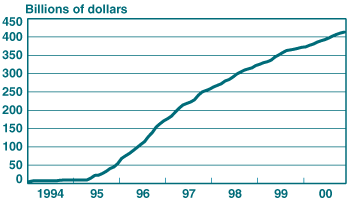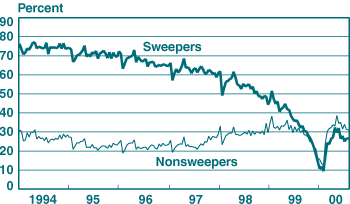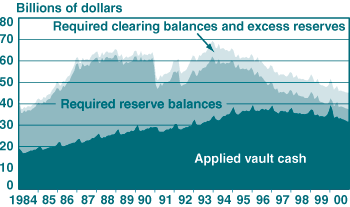| Recapping an article from the May 2002 issue |
|
||
| of the Economic Policy Review, Volume 8, Number 1 | View full article |
||
|
|
16 pages / 573 kb | ||
|
Authors: Paul Bennett and Stavros Peristiani |
Disclaimer | ||
| Index of executive summaries |
|
Overview The authors present evidence that reserve requirements now constrain commercial banks and other depository institutions to a much smaller degree than in the past. They attribute the diminished force of the requirements largely to the spread of "sweep" arrangements—a banking innovation that allows depository institutions to shift funds out of customer accounts subject to reserve requirements. The authors then argue that as reserve requirements have become less binding, banks have been able to economize on the vault cash holdings that they use to satisfy a large part of these requirements. Indeed, banks now appear to be managing their cash flows more in accordance with business needs than with regulatory obligations. Background The Federal Reserve requires banks and other depository institutions to hold a minimum level of reserves against their liabilities. Currently, the marginal reserve requirement equals 10 percent of a bank's demand and checking deposits. Banks can meet this requirement with vault cash and with balances in their Federal Reserve accounts. Neither of these assets earns interest, however, so banks have an incentive to minimize their holdings. Since the beginning of the last decade, required reserve balances have fallen dramatically. The decline stems in part from regulatory action: the Federal Reserve eliminated reserve requirements on large time deposits in 1990 and lowered the requirements on transaction accounts in 1992. But a far more important source of the decline in required reserves has been the growth of sweep accounts (chart). In the most common form of sweeping, funds in bank customers' retail checking accounts are shifted overnight into savings accounts exempt from reserve requirements and then returned to customers' checking accounts the next business day. Largely as a result of this practice, today only 30 percent of banks are bound by a reserve balance requirement (chart). Argument and Methodology The authors undertake to show that reserve requirements are ceasing to bind banks. They find evidence of this development in the fact that required reserve balances have been declining as a proportion of banks' Federal Reserve accounts (chart). Banks are increasingly relying on vault cash to meet their total reserve requirements, with the result that applied vault cash holdings now represent the far largest share of reserves. "Clearing balances"—balances that banks maintain at the Federal Reserve to earn credits that can be used to pay for check clearing, funds transfer, and other Fed services—also now exceed aggregate required reserve balances. As further evidence of the reduced force of reserve requirements, the authors cite the recent behavior of intraday federal funds rate volatility. Banks trying to meet reserve requirements, or to shed unexpectedly large excess reserve positions, typically contribute to increased volatility in the federal funds market on the last day of the reserve calculation period. The fact that volatility on these "settlement" days has diminished relative to the average on other days suggests that an increasing number of banks may be free of reserve requirement constraints. The authors then argue that the ability to sweep away reserve requirements has influenced the way that banks manage their vault cash. Since cash earns no interest, banks not bound by reserve requirements will choose to economize on their holdings of this asset. Thus, the authors hypothesize, "unbound" banks should hold smaller vault cash inventories than "bound" banks and be more aggressive in adjusting their inventories to reflect changes in market interest rates and the currency needs of customers. To test this hypothesis, the authors construct an empirical model of the relationship between banks' vault cash balances and some key determining variables. The federal funds rate is used as a measure of the opportunity cost (that is, forgone interest) of holding cash; growth in transaction deposits serves as a proxy for changes in customer demand for cash services. The model results confirm that bound and unbound banks manage their cash inventories differently. For every percentage point increase in the federal funds rate, the vault cash holdings of unbound institutions decline by 1.8 percent. Although bound banks show some sensitivity to interest rates, unbound banks react more sharply to interest rate changes. Similarly, unbound institutions show the greatest sensitivity to changes in customer demand, significantly increasing their vault cash to accommodate increases in transaction deposits. By estimating the vault cash model separately for three subperiods—1984-89, 1990-93, and 1994-98—the authors find strong evidence that banks over the last decade became increasingly sensitive to the economic costs of holding cash. This finding supports the authors' contention that lower reserve requirements and the availability of sweeps programs in the 1990s have encouraged banks to manage their vault cash inventories more efficiently. Findings Bennett and Peristiani document the diminishing force of reserve requirements, observing that these requirements are "no longer . . . as important a constraint on banks' holdings of assets that qualify as reserves." Banks now appear to be managing their cash inventories less to comply with regulatory minimums than to meet business needs. More specifically, banks appear to be actively regulating their inventories to respond to changes in customer demand and the opportunity costs of holding cash. The authors conclude their analysis by suggesting that a reassessment of U.S. reserve requirements may be in order. With banks becoming increasingly adept at managing their vault cash and Fed account balances to achieve competitive returns, reserve requirements that rely on pricing incentives might be a sensible alternative to the current system. |
|
|
|
|
|
|
| Sweeps of Retail Transaction Deposits into Savings Deposits | |

Source: Board of Governors of the Federal Reserve System. |
|
|
|
Proportion of Commercial Banks Bound
Source: Board of Governors of the Federal Reserve System, Report of Transaction Accounts, Other Deposits and Vault Cash (FR 2900). |
|
|
|
Components of Reserve and Account Balances at the Fed
Source: Board of Governors of the Federal Reserve System. |
|
|
Commentary on article by James A. Clouse |
|
| Disclaimer | |
|
The views expressed in this article are those of the authors and do not necessarily reflect the position of the Federal Reserve Bank of New York or the Federal Reserve System. |
|










